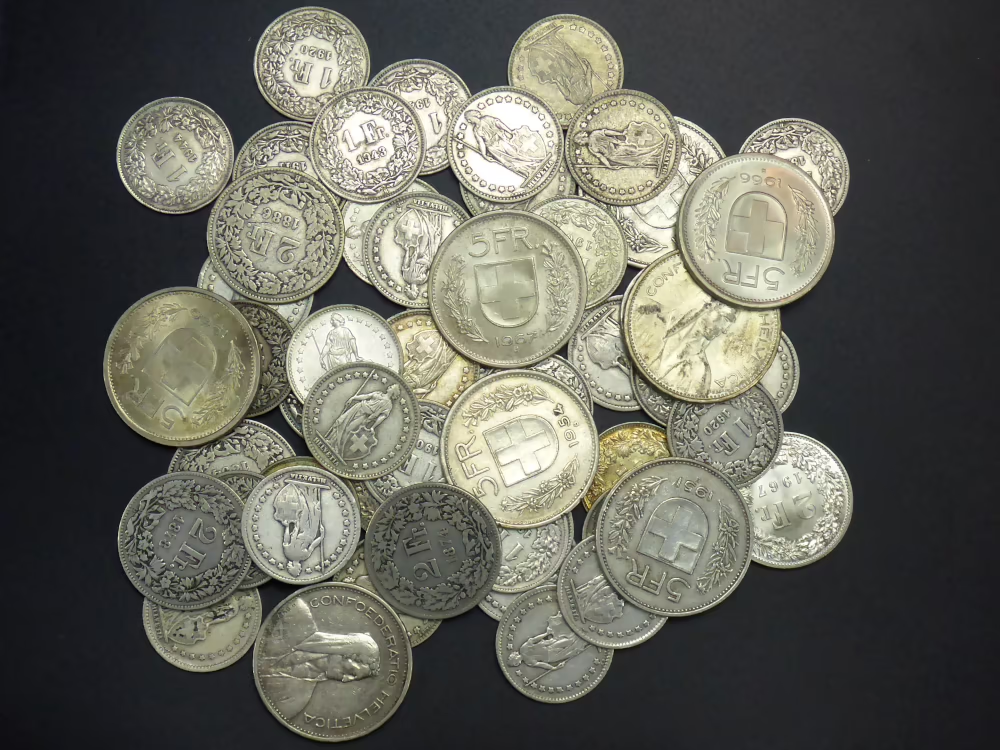Swiss silver coins
Summary
-
Swiss silver coins were only produced after the creation of the Swiss Confederation.
-
The silver coins, which were still in circulation until the 1960s, are close to the price of silver.
-
Coins from the nineteenth century sometimes fetch high collector's premiums.
-
Silver coins are subject to VAT in specialist shops, but not when sold privately.
The latest series of Swiss silver coins are now a popular and inexpensive way to invest in silver. Find out everything you need to know about their value, their history and what to look out for when buying or selling them here.
History of Swiss silver coins
Coins have been produced in Switzerland for hundreds of years. In the Middle Ages, the respective sovereign was granted the right to mint coins by the king or emperor, including the sovereigns in what is now Switzerland. The Frauenmünster in Zurich, for example, obtained the right to mint coins in the middle of the 11th century.
Important note: Disclaimer and riskThis blog post is intended solely for informational purposes and the critical assessment of facts. We would like to help you form your own opinion and better understand the financial markets. This text does not constitute investment advice!
|
Cantonal coins
From the 16th century onwards, the cantons minted their own coins from various metals and in varying qualities. In addition, coins from other territories, especially from the Holy Roman Empire, were also in use due to international trade across the Alpine passes.
The first genuine Swiss coins
The history of genuine Swiss silver coins began with the creation of the Swiss Confederation in 1848. Before this time, the right to mint coins belonged to the cantons, which is why there were no actual Swiss coins, but rather Bernese, Zurich, Schwyz coins, etc.
From 1850 onwards, the federal state minted its first coins based on the French franc. These coins are now traded at well above their metal value and therefore cannot be bought or sold on PreMeSec.

Switzerland in the Latin Monetary Union
Under the leadership of France, France, Switzerland and Belgium founded the Latin Monetary Union. Italy also joined this union in 1865. The member states agreed on a uniform monetary system. Since the value of the currency was contained in the metal in the coins at that time, the coins could be traded 1:1. Nevertheless, each country retained its own currency and its own coins; paper money was not used by these states at the beginning.
This standardisation gave a boost to global trade and also to Alpine tourism, which was still in its infancy at the time. Goods and services could now be traded internationally without complicated currency conversions and exchange rate losses. In the following years, these advantages led other nations such as Greece to officially join, while others such as Austria (with new coins, the guilder) and Russia (with the gold rouble) joined unofficially.
A currency unit (franc, Franken, lire) was defined as 4.5 grams of silver. However, the 1 franc/Franken/lire coins were set at a fine weight of 4.175 grams and 2 franc coins at 8.35 grams of silver. This meant that the value of the coin was not fully covered by the precious metal (token coin). In contrast, the more valuable coins, such as the 5 franc silver coin and the 10 franc and 20 franc gold coins, were covered by the value of the precious metal (full-par coins).
End of the Latin Monetary Union until the last silver coins were taken out of circulation
The Latin Monetary Union began to crumble during the First World War, when countries sought to finance their spending by devaluing their currencies. It finally collapsed in 1926 when Belgium withdrew.
As Switzerland also devalued the currencies of other countries from 1927 onwards and the Latin Monetary Union no longer existed, the value of a coin no longer had to be covered by precious metal. For this reason, the size, weight and purity of the 5 franc coin were reduced in 1931. From this point on, all silver coins had a fineness of 835/1000. The ½, 1 and 2 franc coins were produced unchanged with a fineness of 835/1000 until 1967 and were only taken out of circulation in 1971.
Buy inexpensive Swiss silver coins
The market offers savers who want to buy silver a wide selection. From bars to medals and bullion coins to former circulation coins. In most countries, silver coins have long since disappeared from everyday payment transactions and are therefore difficult to find. In Switzerland, which continued to produce silver coins well into the second half of the 20th century, circulation coins made of 835 silver can be purchased at a price close to the silver price.
The last series of Swiss silver coins consists of the following coins:
| Coin | Production period | Fine silver content |
Fineness |
|---|---|---|---|
| 5 Swiss francs | 1931 - 1967/69 | 12,525 g |
835/1000 |
| 2 Swiss francs | 1874 - 1967 | 8,35 g |
835/1000 |
| 1 Swiss franc | 1875 - 1967 | 4,175 g |
835/1000 |
| ½ Swiss franc | 2,0875 g | 2,0875 g |
835/1000 |
It is important to note that the 5 franc coin from 1968 was made of a copper-nickel alloy!
One disadvantage of circulation coins is their lower purity compared to modern bullion silver coins such as the Vienna Philharmonic or the Maple Leaf. These contemporary silver coins are made of 999/1000 silver. They are also less likely to be accepted on the international market.
Selling Swiss silver coins
Like all old silver, old silver coins can theoretically be sold to scrap gold dealers, but this would be a bad idea. Precious metal dealers only pay the so-called melt price for old silver coins, which is the silver price minus fees for purchasing and melting down the coin. If the coins are in good condition, dealers will usually not melt them down, but resell them directly to investors, charging high premiums and VAT. The trading margin is higher for silver than for gold, so it is advisable not to sell these coins to precious metal dealers, but to find a private buyer for them. PreMeSec's offer is ideal for this purpose.
Register now and sell swiss silver coins!
Swiss silver coins with collector's value
The latest series of Swiss silver coins do not yet have any special numismatic value, which means that collectors pay no or only a small premium on the silver value of these coins. The reason for this is that they were produced too often and are still available in large numbers.
This is not the case with older coins, with the rare five-franc coin from 1928 fetching prices of several thousand francs. When it comes to collector's prices for Swiss silver coins, it is mainly the mintage of the year of production that is decisive, rather than the age. As these coins were only produced for around 120 years, the age differences are relatively small.
FAQ
Why is VAT paid on Swiss silver coins in trade?
-
As Swiss silver coins are no longer legal tender and are traded at close to the price of silver, they are considered a commodity. These coins are therefore subject to tax under Swiss VAT law.
Why do scrap gold buyers only pay the melt price for old silver coins?
-
The silver price on the stock exchange is paid for fine silver, but coins, silver jewellery and silver cutlery are alloys. To produce fine silver from them, they must be melted down. If you deduct the cost of melting and producing fine silver from the silver market price, you get the melt price. It is therefore worthwhile to find a collector or investor for silver coins, as this eliminates the need for melting and allows higher prices to be achieved.
Why buy Swiss silver coins?
-
Those who wish to buy silver coins can also opt for popular coins such as the Maple Leaf, Vienna Philharmonic or Krugerrand. These coins are now produced specifically for collectors and investors. However, the premiums on these coins are usually higher than on old Swiss silver coins.
Should you sell Swiss silver coins?
-
If you have no use for silver coins yourself, you can definitely sell them. However, you should never sell them at melt value. Investors and collectors are keen to buy Swiss silver coins and are willing to pay the silver price or even more.
Do Swiss silver circulation coins have disadvantages compared to silver bullion coins?
-
Swiss circulation coins are made of 835 silver (835/1000) and are therefore less pure than modern investment coins, which are made of 999/1000 fine silver. In addition, they are only tradable internationally to a limited extent.
